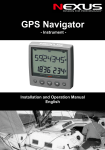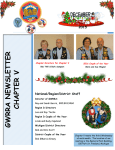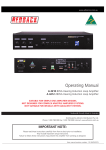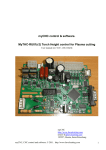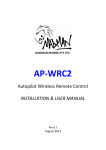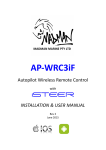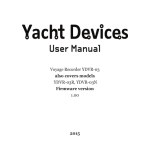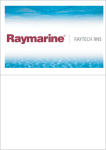Download User Manual Standard Brookhouse NMEA 0183 multiplexer
Transcript
NMEA 0183 Multiplexer User’s Manual Brookhouse www.brookhouseonline.com 2 Preface Thank you for purchasing a Brookhouse NMEA 0183 Multiplexer. This manual describes the installation, configuration and operation of the standard model. Throughout the manual, the multiplexer is ofter referred to as “mux”. Although there are many applications where the multiplexer can be used without a computer, in the majority of installations a computer is part of the integrated system. In the installation description the presence of a (laptop) computer is assumed. Installation Please follow the installation instructions for error-free, reliable operation for many years. 1. Choose a location where you will install your NMEA Multiplexer. The NMEA multiplexer (with or without repeater display) is usually placed in the vicinity of the boat’s nav-station, close to the computer. Please note that both the multiplexer itself and the display are not waterproof, they should not be installed in the boat’s cockpit but inside the cabin at a dry, protected location. Avoid connecting sensitive electronics to the same battery(-bank) as electric winches, start-motors etc. 2 3 2. Determine where your mux will receive its 12V power from. The power should be switched and fused. The NMEA Mux could share the 12V circuit for other instruments or the computer. In case you have purchased the Seatalk option and you will be hooking your mux up to Seatalk, you don’t need a separate power connection. Connect the 3 Seatalk wires as described below. 3. Make sure there is no power on the multiplexer and the instruments to be connected. 4. Connect the wires for NMEA 1, NMEA 2, NMEA 3 and NMEA 4 to the screw terminals. The connections are clearly indicated. It does not matter which instrument is connected to which NMEA input. They are all equal, unless you use data pacing or automatic (GPS) backup switching. If you have a mux with Seatalk support and the Seatalk bus is connected, the NMEA CH1 terminal should be left empty. Consult the instrument documentation of the manufacturer to determine the polarity of the NMEA output wires. The Brookhouse mux inputs are opto-isolated and accept single ended and differential signals. It is often unknown which kind of signal is output by the instrument to be connected. If the NMEA Out connection on the instrument is marked with A and B, it is likely to be differential. Connect to A to A and B to B. If the instrument output is marked NMEA + and NMEA -, connect + to A and – to B. If the instrument has a single wire or connector pin labelled “NMEA out” or “data out”, the signal is single-ended and the common ground is used for signal return. In this case connect the signal out wire to the A terminal of the mux input port and run a separate ground wire from the instrument to the mux B-terminal. Do not simply connect the ground terminal on the mux to the B-terminal. If a computer serial output is connected to a mux input, connect pin 3 to A and pin 5 to B, assuming a 9-pin COM port connector. If polarity is accidently reversed (A to B and B to A), no signal is received, but no harm is done. 5. In installations without Seatalk, make the 12V DC power connection. The red wire is +, the black wire -. 6. For Seatalk: The Seatalk bus has 3 wires: Signal, Ground and 12V. Connect the 12V wire (red) to the 12V terminal. Connect the Seatalk signal wire (yellow) to the special terminal and Seatalk shield (blank wire) to -. If port 1 is used for NMEA, the Seatalk signal terminal should be empty. Please note that if Seatalk is connected, you also have to configure the mux for Seatalk. (see below). 7. Prepare the RS232 cable for the (laptop) computer connection. If the mux has the integral USB adapter, please read the chapter about USB further in this manual. 8. Plug the 9-pin D-type connector of the RS232 cable into the COM-port of the computer. If you use USB, follow the instructions for USB. 3 4 9. Connect any NMEA listeners you have, such as repeater instrument or radar to the differential output of the mux. Usually a maximum of 3 listeners can be connected to the single talker port. 10. Double check all connections. 11. The NMEA multiplexer/repeater is now ready for operation. Apply power to switch it on. Do not switch it on immediately after switching off. Always wait for a few seconds. 12. It is recommended that you first run the setup procedure to select the required features. If e.g. you wish to use the Seatalk option, make sure it is enabled. Connection of an autopilot Autopilot control by a GPS. In most integrated computer/instrument systems autopilot-control is a function of the navigation software. Chart plotters also provide this function. If autopilot control is not supported by the nav software or if this function should also be available when the computer is switched off, in many cases a GPS can also be used directly to send NMEA messages to steer the boat to a waypoint or along a route, depending on the features supported by the GPS. Connect GPS NMEA out to one of the multiplexer input ports and connect the multiplexer RS422 NMEA output to the autopilot input. The autopilot will receive the combined output of GPS and all other instruments and can also be used in wind-vane mode if this mode is supported and if wind-instruments are connected. Note that the mux output baud rate has to be set to a value that is supported by the autopilot. This is usually 4800 bps. Autopilot control by navigation software If the navigation software supports autopilot control (auto pilot track mode), the following applies. Provided that the mux is connected to the computer as shown in the diagram on page 2, auto pilot sentences (APA, APB etc.) are received in the mux via the RS232 RxD terminal. If the mux has the integral USB option, there is a (blue) wire brought out the mux enclosure under the large green connector. It carries the data sent by the computer via USB. This wire has to be connected to the RxD terminal to receive computer data via USB. Data received by the mux on the RS232 RxD port is combined with the data received via the standard input ports CH1 – CH4. The RS232 RxD port is effectively a fifth input, so the standard NMEA multiplexer actually combines 5 input data streams. The 5th input can also be used for other purposes, such as connection of an AIS receiver. Refer to the chapter on AIS elsewhere in this manual. 4 5 In the above described set-up, the auto pilot control sentences, such as APA, APB, XTE, are included in the combined multiplexer data output stream. The auto pilot is connected to the multiplexer RS422 output and receives all combined sentences, but it only uses the ones that are required for steering. Some auto pilots have the ability to display other NMEA data, as a repeater function. The same combined data stream is output via RS232 and USB (if installed). This means that the computer also receives back the auto pilot sentences it has generated, but these are ignored. An advantage of this wiring method is that the auto pilot can receive the NMEA steering sentences from either the GPS directly or from the navigation software on the computer, without the need of physical switching between the two. Alternative auto pilot connection method There is an alternative method of connecting the auto pilot. If the multiplexer’s RS232 RxD port has to be used for a different purpose, the auto pilot can be wired directly to the computer output via the same mux-computer cable, but bypassing the multiplexer. The auto pilot (input) feed cable has to linked to the computer-mux cable as follows: If the computer connection is via RS232, the computer TxD wire has to be removed from the mux RxD terminal and connected to the auto pilot input cable (NMEA in +). In case of USB, the (blue) USB wire has to be disconnected from RxD and connected to the AP feed cable (NMEA In +). In both cases the wire for NMEA – of the auto pilot has to be inserted in the mux RS232 Gnd terminal. Although the multiplexer is bypassed in this way, only the single computer port is used for in- and output and the mux USB interface is used to convert the computer USB output to RS232 for input by the AP. The NMEA standard recommends a differential signal (RS422, “NMEA out”) for the connection to the auto pilot. Whilst RS422 is the preferred signal, as used in the standard mux wiring method described on page 4, the RS232 signal is acceptable for auto pilot input in most cases. Note: If the Autopilot only accepts a baudrate of 4800 BPS , this will dictate the baudrate-setting of the multiplexer output and computer port. The computer port baudrate setting applies to both directions, transmit and receive. If you need to have a mux output data rate of higher than 4800 due to high NMEA traffic intensity and if the autopilot accepts 4800 bps only, there are several options to satisfy these conflicting requirements. Also refer to “baud rate selection” on page 9. 5 6 Uploading waypoints from the computer to a GPS via the multiplexer In many integrated systems, waypoints are only kept in the computer and the GPS ‘s only function is to provide lat/lon of the current position. Navigation tasks are all performed by the computer. However, a number of skippers/navigators prefer to copy waypoints to the GPS, so that the GPS can take over the navigation task if necessary, as a backup. Waypoints generated and managed in software running on the computer can be uploaded to the GPS. If standard NMEA sentences are used for waypoint definition, the GPS NMEA input port can be connected to the mux RS422 ouput port in parallel with the auto pilot (if present) and other NMEA listeners. If a special interactive protocol is used for communication between the computer and the GPS, it is recommended not to wire the computer-GPS link via the multiplexer. NMEA messages generated by other instruments are combined with GPS data and can disturb the proper interaction between GPS and computer. In this case, it is recommended to install a DPDT switch (double pole, double throw) that switches the GPS NMEA in and out ports between multiplexer and computer directly. 6 7 LCD repeater display installation The NMEA Multiplexer model with LCD also works without the LCD connected. Do not plug the LCD in the multiplexer while the power the multiplexer power is on. If required, drill a hole for the cable. If you want to keep the hole as small as possible, remove the shell of the plug and carefully bend the wires sideways. A hole of 18mm will now be sufficient to feed the cable and plug through. Bend the wires back afterwards, make sure you have not broken any and replace the shell. Note: Although the plug used for the LCD-Multiplexer connection is the same as used for VGA monitors, never plug a VGA monitor into the multiplexer and never plug the LCD into a VGA connector of a PC. The pin-outs are not compatible and you will damage the LCD or multiplexer. 7 8 Configuration The setup menu The setup menu is used for setting options and uploading of filtering/editing and LCD directives. The multiplexer has to be connected to the computer via the RS232 port or USB. No special software is required. Use standard Windows program Hyperterminal or any other terminal program. Configure the terminal program (Hyperterminal is assumed in this description) for direct communication via COMx (the port the mux is connected to). Select the following settings: • Baudrate 4800 for standard model multiplexer or current mux baudrate if changed previously. • 8 bits, no parity • No flow control • To list filter/editing or LCD directives one per line, during uploading: In the file menu, select properties. Under settings select Ansi terminal, under ASCII setup, tick Send line ends with line feeds. To enter setup mode, press the keyboard ESC key or / (slash) key in Hyperterminal ( Hyperterminal has to be the active foreground application), while you switch the mux on. The mux recognises the ESC or / key only during the three start-up flashes of the green status led. The following menu should appear: *** Select option by entering single digit or letter: *** 1 - Set baudrate to 4800. 2 - Set baudrate to 9600. 3 - Set baudrate to 19200. 4 - Set baudrate to 38400. 5 - Enable 5th input port. 6 - Disable 5th input port. I - Set port 1: Seatalk, NMEA ID,= $II. S - Set port 1: Seatalk, NMEA ID,= $ST. N - Set port 1: NMEA, Seatalk disabled. F - Upload filtering/editing definitions. L - Upload LCD screen definitions. A - GPS backup: priority port 1, backup port 2. B - GPS backup: priority port 2, backup port 3. C - GPS backup: priority port 3, backup port 4. D - Disable GPS backup feature. P - NMEA Data Pacing (port 2, 1 sec.). Q - NMEA Data Pacing (port 3, 2 sec.). R - Disable NMEA Data Pacing. X - Exit setup. *** Select the option(s) you require by pressing a single letter or number and follow the instructions from the mux. Use uppercase for letters. 8 9 Note 1: Detailed instructions with screen-shots for Hyperterminal can also be found on the following page on the Brookhouse website: www.brookhouseonline.com/Hyperterminal.htm Baud-rate selection The baud rate of the multiplexer’s RS232, USB and RS422 ports can be set to 4800, 9600, 19200 or 38400bps. If no auto pilot has to be connected, set the baudrate to one of the higher values to ensure sufficient bandwidth. The internal buffers of the multiplexer allow for larger amounts of data to be received than can be transmitted at the same time via the output port. However, it will be clear that this is only for short periods. It is not possible to have a sustained total data-inflow that is larger than the capacity of the output port, even with very large buffer lengths. As all NMEA instruments send data (NMEA sentences) in bursts every 1 or 2 seconds, the time gaps reduce the average input rate and the risk that an overflow situation will occur is small, even with the output port set to 4800. If an auto pilot is part of the system, the baudrate usually has to be 4800. Depending on the amount of data produced by the connected instruments, 4800 bps may provide insufficient bandwidth for the combined data. This may result is (occasional) buffer-overflow. If such a situation arises, there are 3 options to resolve this: 1. Use filtering to remove redundant data to reduce NMEA traffic density. In most cases there are many unused NMEA sentences that can be filtered out. 2. Activate ‘Data Pacing’ in the setup menu to increase the time-gap between NMEA sentences 3. Set the baud rate to a higher value and connect the auto pilot to the computer independently. In the configuration setup of your computer’s navigation/chart plotting software, set the baudrate of the COM port to the same value as the mux. The baud-rate of the standard model multiplexer’s NMEA input ports is fixed 4800 baud. Set the baud-rate of the NMEA outputs of the instruments to match this. 4800 is the standard NMEA transmission rate and most instruments will use this as the default setting. The transmission speed of modern GPS’s is usually selectable. 9 10 For NMEA Multiplexer units with LCD display: The Setup menu is available for all models, including the mux with LCD, but for the model with LCD an additional method for selecting some of the options is available using the LCD and selection pushbutton. 1. Turn the power off and wait for a few seconds. 2. Depress the selection push button and keep it depressed while power is applied. 3. The words “Select Option” are displayed on the LCD. Release the pushbutton. 4. Press/release the selection push button until the required baud-rate is displayed. Only 4800 and 9600 bps can be selected this way. Use the setup menu if baudrate 19200 or 38400 is required. 5. Press the selection button and wait until the word “Set” appears. 6. Turn the unit off and wait for a few seconds before switching it on again. 7. Next time the NMEA mux is switched on, the selected baudrate will be effective. Setting NMEA or Seatalk support for port 1 All Brookhouse Multiplexer models If you have purchased the Seatalk option, port 1 has been preset to Seatalk mode and you don’t need to do anything, unless you want to change the Seatalk ID (see below). The NMEA Seatalk ID is the 2 letter code, preceeded by $ (dollar sign), that the mux uses as the prefix for all NMEA messages that are the result of the Seatalk to NMEA conversion. The factory setting for the NMEA Seatalk ID is $II (Integrated Instruments). Sometimes it is advantageous to distinguish the muxgenerated sentences from other sentences starting with $II. For this reason $ST is offered as a menu-selectable alternative to $II. Most software and instruments just look for the $ and ignore the ID code, but if $ST is not accepted, use the Setup menu to change it to II. Alternatively, load an editing directive (Substitute) to change the ID ‘on the fly’ to any required code. Also use the setup menu to disable the Seatalk conversion if required. With Seatalk conversion disabled, port 1 accepts standard NMEA data. For NMEA Multiplexers with LCD: For multiplexers with the optional LCD, an alternative way of enabing/disabling the Seatalk option and selecting the Seatalk NMEA ID is offered: 10 11 1. Turn the power off. 2. Depress the selection push button and keep it depressed while power is applied. 3. The words “Select Option” are displayed on the LCD. Release the pushbutton. 4. Press/release the selection push button until “Port 1 NMEA” appears if you require NMEA for port 1 or until “Port 1 Seatalk” appears if Seatalk support is required. 5. Press the selection button and wait until the word “Set” appears. 6. Turn the unit off and wait for a few seconds before switching it on again. 7. Next time the NMEA mux is switched on, the selected protocol for port 1 will be effective. Follow the same procedure for selecting the NMEA sentence ID (II or ST) for Seatalk data. Note: You can select baudrate, Port 1 protocol and Seatalk NMEA sentence ID without switching the unit on and off each time. USB The integral USB adapter allows connection of the Multiplexer to a computer USB port. USB V1.1 is supported. A Brookhouse supplied driver has to be installed in the computer. This creates a virtual COM-port for communication of navigation software with the multiplexer. The integral USB interface converts USB to RS232 and vice versa. This has the advantage that data sent from the computer via USB is also available at the multiplexer-end as a RS232 signal. If the computer has a serial RS232 port plus a USB connection, the mux output can be connected via both paths. This makes it possible to run 2 applications in the (laptop) computer that both use the output of the NMEA multiplexer. Driver Installation Connect the NMEA mux to the computer USB port with the supplied cable. Leave the power of the mux off at this stage. Windows will usually recognize the USB device as soon as it is connected or as soon as the computer is switched on with the cable already plugged in. Follow the Windows instructions for installing new drivers. If the mux has not been connected before, Windows (all versions) will 11 12 ask for the driver diskette or CD supplied with the USB device. If the USB device (NMEA Mux) is not automatically detected, go to “My Computer”-“Add new hardware”. Although there are differences between Windows versions in the way new drivers are installed, the principle is the same: Specify the location where the new driver can be found. When asked which location should be included in the search, click on Browse and find the drive and directory where the driver is stored. After the installation of the driver is complete, go to “My Computer”-“Control Panel”-“System”-“Device Manager”. Click on “Ports” and check which port number has been assigned to the virtual USB COM port. Use this COM port number in the configuration section of your Navigation software or other application that will read the NMEA mux output. Make sure that the baud rate of the NMEA Mux and the baud rate in the COM port configuration of the navigation software are the same. Other required settings are: 8 bits, no parity, no flow control. If for some reason the USB connection does not seem to be working or the application reports errors when attempting to open the port, terminate the application, switch off the multiplexer, remove the USB cable from the multiplexer, wait a few seconds and plug the USB cable back into the mux. Then restart the software, and switch on the NMEA mux. “Crazy Mouse” Problem Under certain circumstances, if the USB device is connected and already sending data to the computer when Windows is started up, Windows will “think” that the connected device is a pointing device (Microsoft Ballpoint device or other). This is a general problem with USB serial devices and can also occur when a GPS or multiplexer is connected via USB. Here follows a remedy: Switch the multiplexer off to stop sending data to the computer but leave the USB connection intact. This will stop the uncontrolled cursor moving over the screen. Go to My Computer > Control Panel > System. Click on Hardware tab, Device Manager and click on Mice and other pointing devices. Find the device that was incorrectly identified as a mouse (Ballpoint device) and double click on it for the properties. Under Device Usage select Disable. From now on the USB device will no longer be recognized as a mouse. 12 13 NMEA Control functions GPS backup switching Many navigators decide to install a second GPS for backup, to take over from the primary GPS when it fails, for whatever reason. However, it is not always immediately known if the primary GPS stops sending data to the navigation software. If the navigation computer has been unattended for some time, the position in the electronic chart may not have been updated for a while because no GPS NMEA sentences were received. Typically, the boat' s position is checked if there is a potential navigational hazard, when an up-to date position is most needed. To discover at that time that the GPS has stopped could not be more inconvenient and dangerous. Preparing a backup GPS to replace the primary can take valuable minutes. The solution lies in using a NMEA multiplexer and have the primary and a backup GPS permanently connected. If one GPS stops, the other will still send GPS sentences with lat/lon. Chances that both GPS units fail at the same time are low. However, permanent connection of 2 GPS units can be undesirable, because the frequency at which lat/lon is sent to the navigation software is doubled and sentences may be sent through the multiplexer with a very short time-interval, as the 2 GPS' s are independent. The navigation software may not be able to handle the data from 2 GPS' s and/or may slow down or even fail. All Brookhouse multiplexers now have a feature that resolves this problem in an elegant way. One multiplexer port can be designated the "primary GPS port" and a second port the "GPS back-up port" in the setup menu. As long as NMEA sentences are being received via the primary GPS port, data from the back-up port is blocked. If no data is received for 10 seconds, the back-up port is unblocked and the backup GPS takes over from the primary. When the primary GPS starts sending NMEA data again, data from the back-up port is no longer sent to the computer. If GPS backup switching is used with channel 1 as the primary input channel, port activity (or the lack thereof) is not used to determine if the GPS is active or not. Instead, the data stream is analyzed for the presence/absence of a certain NMEA sentence. This way, if the data stream received via channel 1 also contains other than GPS data, GPS (non)activity can be sensed, while other instruments continue sending data. This feature has been designed to sense GPS activity in systems with Seatalk. If the Seatalk option is active, the SeatalkNMEA conversion in the mux results in a mixture of NMEA sentences, including GPS sentences, so if the GPS stops sending, this cannot be detected by looking at port activity only. To enable selective sensing of the sentence type on channel 1, two steps are required: 13 14 1. Select GPS backing switching option A in the mux setup menu. (primary port is 1, backup is 2) 2. Upload the following script with option F: *C,1,IIRMC,0,2,0,0 *E NMEA Data Pacing The NMEA standard recommends that NMEA sentences produced by individual instruments are sent at a frequency not higher than once per second. Some instruments, especially some electronic compasses and engine function sensors, send their NMEA sentences at much higher frequencies. This can cause serious congestion in integrated instrument/computer systems, especially if these sentences are combined with data from other NMEA talker sources. The amount of data to be processed by the computer software can be so large that it slows down significantly and some programs stall. Many of the values contained in sentences sent at these high frequencies change very little from one sentence to the next. For example, it is unlikely that the vessel' s heading changes much in half a second time. The same heading value is likely to be sent repeatedly over and over again. The Data Pacing mechanism in Brookhouse NMEA Multiplexers, if activated, blocks data received from a selected port for short periods, to insert time gaps in the data stream and give the computer or other NMEA listener some "breathing space". For example, one second interruptions can make a considerable difference and alleviate the system load whilst it is unlikely that the sentences suppressed during that single second will contain significant changes. After a block period, sentences are allowed through again for a short period of time. The block period always starts after a complete sentence has been received and when after the time-out data is sent through again, it will always start with the beginning of a new sentence ($). Together with the filtering feature, data-pacing allows the user to fine-tune and optimize the integrated instruments/computer system to the maximum. Data-pacing is activated from the mux set-up menu, but if only the standard mux functionality is required, nothing has to be done, as with other advanced multiplexer features. 14 15 Filtering and “on the fly” editing. A separate description is available from Brookhouse. Creating and uploading LCD screen directives A separate description is available from Brookhouse. Common problems with using Setup and uploading directives using Hyperterminal. 1. The setup menu does not appear in the Hyperterminal window when mux is switched on while ESC is depressed. Cause 1: Hyperterminal is not the active foreground application. The Hyperterminal window may be on the screen, but if Hyperterminal is not the application that has control over the keyboard, the ESC key is not sent to the mux. Check if the Hyperterminal title bar is greyed and if so, click on it to resolve. Cause 2: Wrong baudrate. The first time Setup is used, set the baudrate to 4800. If the mux baudrate is changed and setup is used again later with the Hyperterminal baudrate still set at 4800, the ESC code won’t be recognised due to baudrate mismatch. Always set Hyperterminal to the current mux baudrate before attempting Setup. 2. When starting a directives upload, the error Message format error appears. Cause: Another file transfer method than Transfer Text file was selected. Always use the Transfer Text File option in Hyperterminal. AIS receiver connection Introduction The standard Brookhouse NMEA multiplexer supports the connection of an AIS receiver via the configurable RS232 input port. This port provides a fifth input channel for high speed NMEA data (NMEA 0183 HS). The other 4 ports remain available for NMEA and (optional) Seatalk. The 5th input is enabled by default, but can be disabled in the setup menu if required. For the connection of an AIS receiver, the multiplexer baudrate has to be set to 38400 bps in the setup menu. The high speed AIS data is combined with the lower baudrate data from the 4 15 16 standard NMEA ports and transmitted as a single data stream to computer or chartplotter at 38400 bps. The high baudrate, which also applies to the mux output port, means that standard NMEA listeners at 4800bps, such as auto pilots, cannot be connected to the mux output port. There are many applications where this is not a problem. For example, in systems where the auto pilot is connected to a chart plotter via Seatalk, and computer AP control is not required, the lack of NMEA output at 4800bps is not a disadvantage. For those configurations where both 38400 in and output for AIS plus 4800 bps NMEA output is required, Brookhouse has 2 different models of NMEA multiplexers with baudrate conversion: models AIS and AISC. The four standard multiplexer input ports are opto-isolated. The RS232 port used for connection of an AIS receiver (standard mux) is not opto-isolated. The popular AIS receivers have been designed for direct connection to a (non optoisolated) RS232 computer port and connection via the mux RS232 port presents no problems for any of the popular AIS receivers available. Use of the RxD port The 5th input port (RxD terminal on the multiplexer) is also used for bi-directional communication with a computer during configuration/setup of the multiplexer. Multiple devices cannot be connected to an input port at the same time. Therefore, the AIS receiver (or other NMEA talker, HS or standard) should only be connected after the setup procedure has been completed and the port is free for other use. After setup, the computer Tx D wire has to be disconnected from the mux RxD screw terminal and the AIS receiver or other NMEA talker can now be connected. If setup is regularly required for uploading filter/editing data or LCD screen definitions, installation of an external single-pole change-over switch may be considered for convenience. If the communication with the computer is via USB, the integral USB-RS232 converter has to be disconnected from the RxD terminal for the same reason as explained above, before the AIS receiver can be connected. For this purpose, the blue wire in the RxD terminal for models with USB option should be removed and insulated after configuration, before the AIS receiver or other NMEA talker is connected. If no AIS receiver or other external NMEA talker is installed, the RxD port can stay connected to the computer all the time. After mux configuration, NMEA data sent back to the mux by the computer, will be combined with the other inputs to a single data stream. For example, auto-pilot control sentences generated by the computer nav software can be input by the mux in this way to be combined with 16 17 other input data. In case of USB communication the blue wire can stay in place. Also refer to the chapter in this manual dealing with autopilot connections. Baud rate considerations If a high-speed NMEA talker is connected, a consequence is that the output baudrate of the multiplexer has to be set to the same rate. The risk of data-loss would be too high if the output baudrate would be lower. Therefore the baudrate of the 5th input port and the mux output data rate are coupled and automatically set to the same value during the mux setup procedure. As standard NMEA listeners such as auto pilots and repeater instruments usually accept only 4800bps, these cannot be directly connected to the mux output if the selected baudrate is higher than 4800. However, in most navigation software packages a separate output port can be configured at 4800bps for auto-pilot control. There are also Brookhouse multiplexer models available with baudrate conversion to allow connection of low-speed NMEA listeners. Multiplexer operation The multiplexer is fully automatic. Once power is applied, it starts looking for input data on all 4 input ports and outputs NMEA sentences on the RS232 output port. LED’s (Light Emitting Diodes) The two led’s have the following function: Red led (pwr): Green led (stat): This is on when power is supplied to the multiplexer. When the multiplexer is switched on, three short flashes indicate that the processor is running and no faults have been detected. After initialisation the green led is on when a NMEA sentence from one of the input ports is being transferred to the output port. LCD (only for Multiplexer model with LCD) The LCD is used for displaying selected NMEA data found in the data-stream of any of the four connected instruments. The multiplexer is supplied with a number of screen definitions for often displayed data. The user can change these definitions and/or add more to display additional data or data-combinations. The 17 18 display function is independent from the multiplexer-function. All data is transferred to the output port as it has been received from the inputs, but the multiplexer filtering/editing feature allows the user to program the multiplexer to suppress certain sentences and/or make modifications. Data from NMEA sentences that are filtered out or modified can still be displayed on the LCD. Separate documents are available that describe how to program the multiplexer for filtering/editing “on the fly” and for programming the screen definitions for the LCD. Data-screens can be displayed sequentially by pressing the push-button. After an item is selected, it may take a few seconds before the data is displayed, because the multiplexer has to wait for the next NMEA sentence containing the data to come along. The latest data received is displayed. If a screen is selected but no value is displayed, that data-item is not available in the NMEA sentences received from the connected instruments. After no data has been received for the current LCD screen for a period of 10 seconds, the first character of the screen starts blinking. This indicates that if any data is currently still displayed, this data is not up to date and cannot be relied on. The curser stops blinking after fresh data becomes available. Changing the default (power-up) screen When the NMEA Multiplexer is powered on, the default data-screen is displayed. This default can be changed by the user in a very simple way. Step through the screens by pressing the pushbutton until you find the one you wish to select as the power up default. Press the selection button and keep it depressed until the word “Set” appears. You don’t have to wait until the actual data is displayed, just select the sentence type and description. When “Set” appears, the power-up screen number has been set in the mux’s eeprom memory. Next time you switch the NMEA multiplexer/repeater on, the selected screen will be displayed first. Turn the power off, wait for a few seconds and turn power on. The selected default screen will now appear. Turning the LCD backlighting on and off On sailboats, power preservation is important while under sail. The mux uses very little (approx. 50 mAmps), but the LCD backlighting uses another 100mAmps. This is still not much, but every little bit helps. To switch the backlighting off, go through all the displays by pressing the selection pushbutton. The last screen is fixed and shows –END-, the firmware revision number and <backlighting on/off>. Keep the button depressed until the backlighting switches on or off. 18 19 NMEA sentence monitoring If you wish to check if all NMEA data sentences that you are expecting are included in the output of your instruments and the NMEA multiplexer, you can easily verify this by running Windows program Hyperterminal (under Accessories). This will display all “raw” NMEA data, sentence by sentence. Don’t forget to set the correct baud rate. Also, after changing the baud rate, Hyperterminal has to be terminated and re-started. You can also use your computer to simulate NMEA instruments on the input ports of the NMEA multiplexer/repeater. Do not use Hyperterminal for this purpose, because the multiplexer will “lock” on the input port until a LF (Line Feed) character is encountered. There is an NMEA Instrument simulation program available (free trial version) on www.sailsoft.nl Support The software for our products is regularly updated and new functions added. If in future you require a new features which are not included in the version of the product you own, we are happy to install the latest software in your unit for a small service fee. Questions or Comments Please feel free to send us an email to [email protected] in case you have questions, requests or comments. On the website http://www.brookhouseonline.com you can find more technical info. 19 20 Specifications • • • • • • • • • • • • • • 4 opto-isolated “Listener” (Input) ports for the connection of NMEA "talkers" (GPS, Windinstr. etc.). RS232 input (Computer or AIS) for fifth input. 1 Output RS232 port (typically for connection to computer) 1 Output RS422 port (differential NMEA talker port) Data speed: 4 Input ports: 4800 bps (standard NMEA baud rate), RS232 Input & Output: 4800/9600/19200/38400 bps selectable in setup mode, default 4800 bps. Indicators: red LED for power, green LED for data-transmission. Supply Voltage: DC 9-35 Volts. Reversed polarity protection. Power Consumption: 45 mAmps. @ 12V (with all ports active) Physical size: 110x65x37mm (hxwxd) Weight: 120 grams Mounting: bulkhead mounting with screws. NMEA management and control: o NMEA Sentence Filtering o NMEA Sentence editing “on the fly” o Automatic port switching (mainly for GPS backup) o Data pacing for fast talking sensors and electronic compasses. Options: o Raymarine Seatalk to NMEA conversion. o USB for computer connection. o User programmable LCD (compact repeater) Disclaimer Although we do our best to make our products highly reliable, we cannot accept any responsibility for personal injury, loss of life or material damage as a result of malfunctioning of our products. 20





















